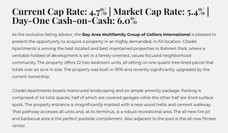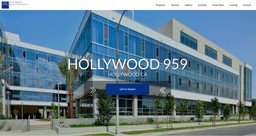
Marketing Best Practices
How to Write a Great Property Description
Commercial real estate marketing requires considered investment in a number of resources, but one of the most important is the property description that sits at the center of your campaign.
To guide you in crafting a high quality, results-oriented property description, we’ve outlined the core elements you should include along with real property description examples that you can use as a template for marketing your next property.
With the right approach to your target audience, location, and property description best practices, you can produce an enhanced property description that generates more leads and helps existing prospects find the information they need quickly.
How to Write a Property Description
Your commercial real estate description is a summary of everything that matters most about the property.
This is where you tell the story of your property, the location and amenities of the property, and any other relevant details.
Imagine you are having a conversation with a prospect.
What details would you highlight when introducing the property to them?
Below we’re outlined 5 major elements and 8 useful tips that can help you optimize your property descriptions along with concrete examples you can use for inspiration.
1. Craft a Great Headline
The headline is the hook – the billboard that will determine if someone stops skimming through dozens of listings and clicks through to read yours.
If your headline doesn’t speak to the specific needs and interests of the people who are most likely to be interested in your property, you’ll lose them.
How do you ensure it is effective?
- Be Specific – The more detailed your headline is, the more effectively it will target the right, qualified buyers who are a good fit for your property. Vague, detail-thin headlines can attract a lot of false positives, while pushing away people who are in a buying mindset.
- Be Professional – Show your expertise by including key details that matter to investors. Square footage, the style of the property and the location are all key details that are often relevant at this stage of a prospect’s search.
Capture attention quickly with a headline that speaks to the specific needs of the target prospects you want to look at your property.
2. Tell a Compelling Story
Many property descriptions are short, uninteresting and loaded with facts and figures. There is a place for those numbers, but it’s not your property description.
This is prime real estate – the top block of text prospects will see when they land on your website and the most effective way to engage with them in the sales process.
A good description should be a narrative. It should tell the story of your property. It should focus on the emotions that the property and its amenities evoke. This is where you can describe the style of the property, the history of those who have operated there, and the importance of its place in the neighborhood.
You’re not just selling a property – you’re selling a component of another company’s brand. This property will become part of how they present themselves to prospects and customers. How will it do so?
Property description example:
Current Cap Rate: 4.7% | Market Cap Rate: 5.4% | Day-One Cash-on-Cash: 6.0%
As the exclusive listing advisor, the Bay Area Multifamily Group of Colliers international is pleased to present the opportunity to acquire a property in an highly demanded, in-fill location. Citadel Apartments is among the best located and best maintained properties in Rohnert Park, where a veritable hotbed of development is set in a family-oriented, values-focused neighborhood community. The property offers 22 two-bedroom units, all sitting on one quaint tree-lined parcel that totals over an acre in size. The property was built in 1976 and recently significantly upgraded by the current ownership.
Citadel Apartments boasts manicured landscaping and an ample amenity package. Parking is comprised of 44 total spaces, half of which are covered garages while the other half are lined surface spots. The property entrance is magnificently marked with a new wood trellis and cement walkway. That pathway accesses all units and, at its terminus, is a robust recreational area. The all new fire pit and barbecue area is the perfect poolside complement. Also adjacent to the pool is the all new fitness center.
3. Emphasize the Location
Beyond the property, go into greater detail on the location, surrounding businesses and amenities. Elements like foot traffic, the vibe of the neighborhood, and more will have a direct impact on many businesses as they enter a new neighborhood. Your description of the location will largely depend on the type of investors or tenants you are looking for as well.
Photography plays a prime role here. Invest in a professional real estate photographer who can take appealing photographs that augment and highlight the most important elements of your property while reframing any potential negatives.
Technology now makes it possible to supplement photography with inexpensive video tours and 3D property tours as well.
Depending on your prospects and the type of property you’re promoting, consider the role that these technologies might play.
Property description example:
Directly overlooking Fan Pier’s activity and Boston Harbor, 100 Northern Avenue @ Fan Pier pairs breathtaking views of Boston’s waterfront with a magnificent backdrop of the city skyline.
4. Focus on Key Facts and Features
While your property description is the narrative base of your marketing efforts – the shiny coating that will capture the attention of prospective investors and guide them into a sales conversation – the facts, features and highlights of your property are equally important.
This is the information that will be referenced throughout the sales process and help filter prospects based on key features that matter most. Specific information you should list includes:
- Size of the Property – What is the total square footage of the building and the lot? Are there relevant sizes or segments of the building to highlight?
- Market Information – What type of property are you listing and who is it designed for? You’d be surprised how many listings neglect information about the Class and property type.
- A List of Amenities – What is included with the property? Is it primed for a certain type of business (restaurants, for example)? Are there nearby bus stops or train stations? Highlight what you feel your prospects will care most about.
- Capital Improvements – What improvements have been made and how recently? What opportunities are there for further updates?
- Demographic Information – Highlight neighborhood information like walking score, transit score, the age breakdown of the neighborhood, average income and other factors that might influence an investor’s decision.
- Tenant Information – What companies are already tenants in the building? Who has been there in the past and how successful were they? These are things your prospects will care about.
Invest some time to include a comprehensive list of accurate information here. It will help filter prospects and ensure only qualified investors or tenants contact you about the property.
Property description example:
KEY FACTS
- 97,189 SF retail shopping center
- Miami-Dade’s largest and most dynamic submarket with over 19 million SF of retail and an impressive 97% occupancy.
- Stable tenant mix with average tenant duration over 10 years.
- Going-home side of Kendall Drive.
- 5-mile density is an impressive 5x greater than Miami-Dade average.
- Average HH income of greater than $81k within 5-miles.
5. Don’t Forget a Call to Action
The final element of your property description is the call to action – the language and button through which someone reaches out and engages with your company. The call to action you use will largely depend on what you want prospects to do.
Are you scheduling tours? Fielding calls? Channeling outreach to specific people in your company?
Make sure you very specific about what they are requesting when they click the call to action button. This is how you will actually capture and nurture new leads.
Keep the below tips in mind next time you write a description that will be featured in your commercial real estate website design to improve your chances of converting visitors to potential prospects
6. Keep it Short
Provide the facts quickly in clear English. Nobody wants to read a wall of text so use this opportunity to succinctly provide all the key information that is relevant to your target audience.
Remember:
The majority of your audience are scanning through your listing, not actually reading!
A good rule of thumb is to write descriptions that are between 80-150 words in length. Less than 80 words is a bit too thin and more than 150 words starts to become very dense.
7. Accentuate the Key Amenities
The property description is a great place to reaffirm both building and local amenities. Consider highlighting a few of the key “stand-out” amenities using positive descriptive phrases.
This is not a place to include a laundry list of all features and specifications.
Keep it short and sharp.
If the building itself is uninteresting, then focus on the submarket and access to transportation and surrounding points of interest.
8. Highlight the Other USPs
In commercial real estate, there are a lot of “unique selling points” apart from the building itself.
Besides the physical property there is other specific information that could be very relevant to your client that you should consider including.
For example: zoning, tax credits, new area developments, etc.
Use the USPs appropriately to seduce your buyer.
9. Define the Audience
Who is this property for?
Spell this out.
The best property descriptions clearly tell you who the ideal tenant or buyer would be.
Not only can this save you time and get rid of inquiries from irrelevant leads, but it can also open the door to leads that might not have previously considered your property as a viable opportunity.
10. Reinforce “Social Proof”
Social proof can be a powerful way to give your property listing instant credibility and make your building much more attractive.
Two easy ways to sway your buyers are by focusing on:
- Quality of tenants or
- Quantity of tenants
If your property is home to notable anchor tenants, you might want to consider dropping a few names. Nothing can better attest to the quality of a property better than the quality of its tenants.
Another option is to include the number of tenants at the property or in the neighborhood (for example: “East Cambridge is home to over 120 high-tech companies”). The quantity by itself can have a powerful effect.
11. Optimize for SEO Friendliness
Typically, the property description is the first large chunk of text Google will see on your page so make sure you consider including SEO-friendly phrases.
Two important elements to remember to always include are the:
1) property type and
2) location
Here is an example of SEO-optimized lead sentence: “123 Main Street is a mixed-use property available for sale in West Hartford, CT…”
Why?
Because most tenants and investors will include a combination of those elements in all of their Google searches when looking for property. So make sure you have your bases covered for SEO.
12. Check Spelling and Grammar
This is basic: Incorrect spelling or grammar is a red flag that screams “sloppy”.
Don’t risk losing the confidence of a buyer because of a spelling or grammar mistake. Have someone (other than you) double-check your writing.
13. Break Up the Text
If you want to encourage your audience to read through and digest the content from your description, then break up your text into smaller paragraphs.
Don’t make the mistake of writing a large block of text.
This not only improves readability but also makes it much more appealing to your potential clients.
Property Description Examples
Example 1 – Office Tower
University Tower is a 17-story Durham landmark building, offering unique Class A office space with stunning views of Durham and Chapel Hill. Positioned equal distance between downtown Durham and downtown Chapel Hill, University Tower offers professionals easy access to both “city centers,” I-40, Research Triangle Park, and RDU Airport. Visible from 3 miles away on approach from I-40, the sparkling emerald colored Tower is seen rising above the pine trees with its tall spire.
Amenities include the exclusive penthouse floor University Club Restaurant, bar, and private dining/meeting rooms, on site professional property management team, (4) high speed elevators, and new Trane Building Management System. Floors may be subdivided as needed to accommodate any size business.
Example 2 – Retail
Located downtown in the heart of Chicago’s Magnificent Mile, The Retail at the Realtor Building is a world class retail space on the ground floor of the prestigious Realtor Building, 430 Michigan Avenue.
This prime retail oasis boasts 207 feet of wrap around storefront, with 33 feet of frontage on North Michigan Avenue, expansive windows and high ceilings of 13 feet. Situated in a high traffic area of up to 55,000 people per day, neighboring retailers include The Shops at Northbridge anchored by Nordstrom’s, Burberry, Louis Vuitton, Ermenegildo Zegna, Apple, Forever 21, GAP and recently signed Under Armour.
Related Blog Posts
CRE Technology
5 Reasons Why Salesforce Needs a CRE Marketing Platform
Salesforce isn’t only the most widely used CRM, it’s also the leading choice in the...
Company updates
Streamline Your Outreach with Tag-Based Email Campaigns
We are thrilled to announce the launch of our new Tag-Based Email Campaign feature, designed...
Company updates
SharpLaunch Announces New Integration with LandSearch
We’re excited to announce a groundbreaking integration with LandSearch, a prominent online...







